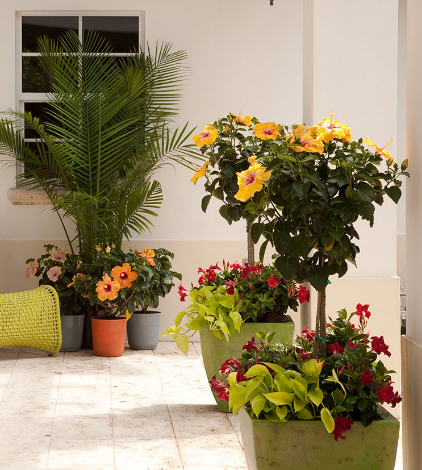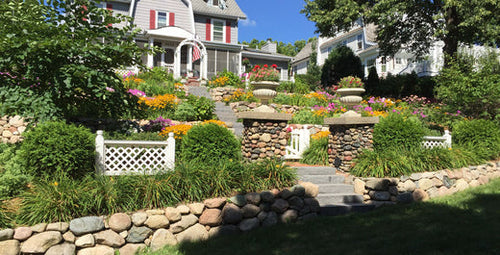
1. Design More with Less
One simple way to design container gardens that have a lot of impact are to incorporate bicolor flowers, or those plants that have multiple colors in each bloom. Here, for example, a purple-and-white petunia puts on a stunning show with its eye-catching two-tone blooms. It's accented by pure white verbena and cobalt-blue lobelia.Bonus design tip: Because white flowers are a neutral color, they look good as an accent with any other plants.

2. Make It Visible from a Distance
Colorful containers that have bold, brightly colored plants are visible from across the street or down the block. These highly saturated colors are ideal for catching attention and adding high style to your favorite outdoor living space. Here, the look is accomplished by golden-yellow bidens, rich purple calibrachoa, and vivid burgundy-red verbena.Bonus design tip: Complementary colors, or those across from each other on a color wheel, almost always make an arresting combination. Here, it's done with purple and yellow.
Get tips on keeping your container gardens alive over summer.

3. Employ Colorful Foliage
Don't rely on flowers alone! Take your containers to the next level by incorporating easy-care plant varieties that have colorful or variegated foliage for extra visual impact. In this hanging basket, a single plant (SunPatiens Tropical Rose impatiens) puts on a fabulous show thanks to its yellow-and-green leaves and rosy-pink flowers.Bonus design tip: SunPatiens grow in sun or shade. In shaded places, lighter, brighter colors -- such as the variegation found in the leaves -- stand out better than deeper, richer tones.
Get more ideas for designing your own hanging baskets!

4. Complement Your Yard
Ensure your container garden designs feel like a part of your overall plan by echoing plants or colors found in your landscape. This container, for instance, uses a creamy-white verbena that picks up on the variegation found in the ribbon grass (Phalaris) in the nearby planting bed. Peachy-orange calibrachoa plays off peachy-orange flowers farther back in the landscape. Purple petunias offer an elegant accent.Bonus design tip: Use plants, such as the calibrachoa here, to cascade over the side of the pot and give your containers a lusher, fuller look.

5. Take Advantage of Contrasts
Contrasting colors -- such as light and dark -- add excitement and visual drama to container gardens. Here, it's done simply with two shades of viola. The bright yellow flowers do a great job of catching attention, and make the deep, dark purple flowers look even richer and more mysterious. Violas like this are ideal for cool-season containers in early spring, autumn, or winter, depending on where you live.Bonus design tip: If you use multiple varieties of the same plant, pay attention to the plant size so they stay in scale with one another. Some violas get larger than others, so you don't one to overgrow the other.
Get more cool-season container garden ideas.

6. Keep It Easy-Care
It's one thing to design a container that looks stunning, but it's another to keep it looking good. Use low-maintenance, low-fuss plants -- such as begonias -- to ensure your container creation goes the distance. Keep in mind that different plants will be easy to care for in different conditions; so make sure you know the light, water, and temperature levels your plants will be exposed to when selecting your varieties.Bonus design tip: One of the fantastic things about begonias and other varieties that thrive in both sun and shade is that you can use them in different areas to keep a consistent look.

7. Incorporate Fragrance
Enjoy your containers on multiple levels by incorporating plants that have wonderfully fragrant flowers or foliage. Here, for example, purple sweet alyssum adds a honey-like scent to a planting with purple bacopa and calibrachoa. Be sure you do the scratch-and-sniff test when planning your containers -- different varieties have different scents, and we all interpret scent differently.Bonus design tip: Don't forget about the container you're planting it. It can be as much -- or more -- of an accent than some of the plants and can really add to your space's overall style.

9. Make It Monochromatic
If mixing colors is a challenge for you, put them together like a pro by sticking with one color, but different shades. Here, for example, a silvery-purple petunia serves as a focal point. It's accented by a lavender-purple lobelia and dark purple verbena. You can rarely go wrong with single-color designs.Bonus design tip: If your containers are in an area where you'll see them in the evening or at night, use light-colored flowers such as these petunias. They reflect light, making them more visible when the sun goes down.

10. Play Up Texture
We tend to focus on color when putting different plants together, but don't forget about the wonderful effect that different textures can provide. Here, big bold petunias play off the smaller, delicate, airy look of baby-blue lobelia and red-and-yellow bidens. Using a lot of soft, airy textures in containers can help small spaces appear larger.Bonus design tip: Don't forget about pollinators! Plants such as this bidens are especially good at attracting butterflies and other pollinators to your favorite spaces.
Get more with our Container Garden Guide.

















